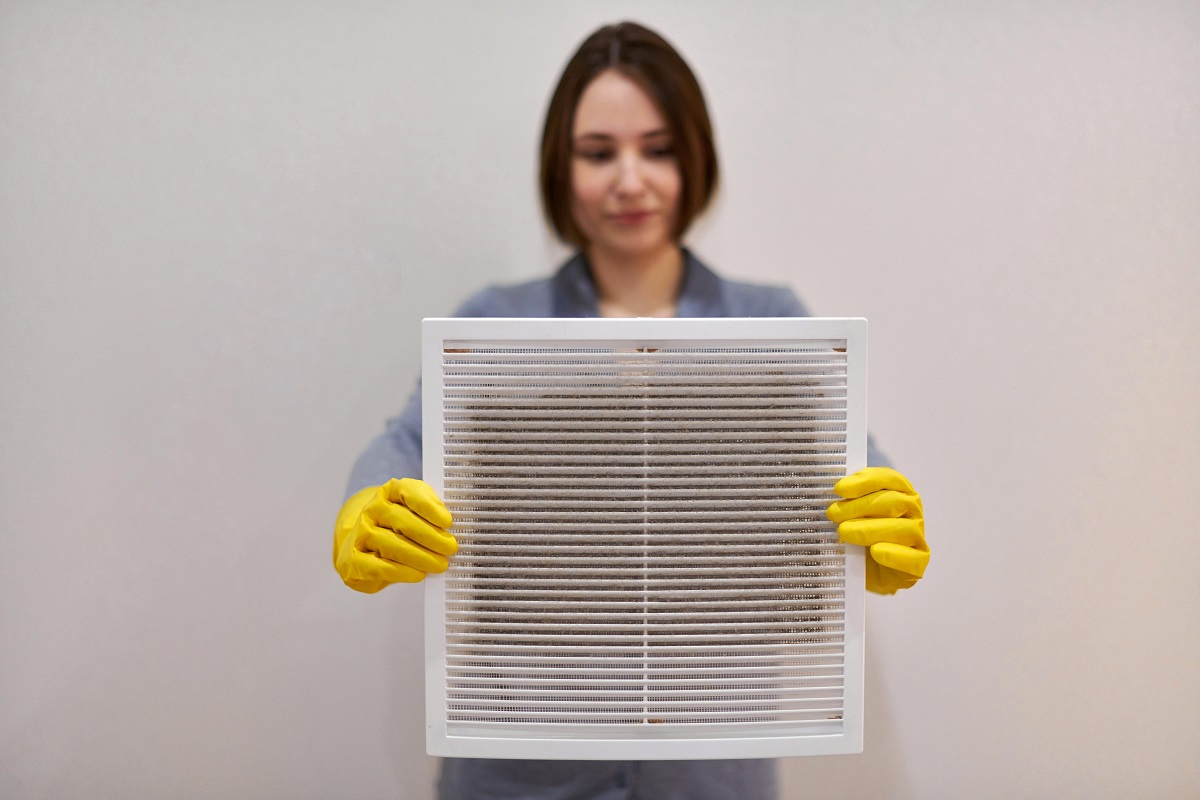Indoor Air Quality Check: Breathe Easier & Sleep Deeper

How to Do an Indoor Air Quality Check for Better Sleep & a Healthier Home
Table of Contents
TL;DR: Key Takeaways
- Recognize the Signs: Persistent dust, lingering odors, and allergy-like symptoms are common signs of poor indoor air quality that you shouldn't ignore.
- Perform Simple Checks: You can begin your indoor air quality check today with easy, no-cost methods like visual inspections and "smell tests" to identify potential problem areas.
- Understand the Sleep Impact: The impact of indoor air on sleep is significant; pollutants can disrupt sleep cycles, leading to grogginess and affecting long-term health.
- Improve Air Naturally: You can find effective ways to improve indoor air quality naturally by focusing on ventilation, managing humidity, and making mindful product choices.
- Choose Healthier Bedding: Your bed is a micro-environment. Opting for eco-friendly bedding for better air, like Nestwell's organic cotton, is key to creating a healthy sleep environment free from irritating chemicals.
Introduction
Wondering how to check air quality at home? It’s simpler than you might think and is the first step toward creating a truly restful sanctuary. If you wake up feeling less than refreshed, or if a stuffy nose seems to be your constant companion, the invisible air in your bedroom could be the reason why. An indoor air quality check is not just for experts; it's something you can start today to make your home a healthier, happier place.
In our journey to create the coziest homes, we often focus on things we can see and touch, like soft blankets and plush pillows. But true comfort is about more than just feel. The connection between home comfort and air quality is powerful. The cleanest, most inviting space can feel off if the air is stale or full of irritants. Fresh, pure air contributes to that feeling of well-being we all crave.
This guide will walk you through a simple indoor air quality check, explain what to look for, and provide actionable steps to help you breathe easier and sleep deeper. We will uncover the common culprits that affect your air and give you simple, natural ways to fix them.
At Nestwell, creating your personal retreat is our passion. We believe that comfort goes beyond just the feel of your sheets—it includes the very air you breathe while you rest. Let us guide you toward building a home that not only looks beautiful but feels wonderfully healthy from the moment you step inside.
Benefits and Impact
What Are the Real Benefits of Clean Indoor Air?
Taking steps to improve the air quality in your home offers more than just a fresh-smelling space. The benefits of clean indoor air are real, tangible improvements that can enhance your daily life and overall well-being. When you reduce the amount of dust, chemicals, and allergens floating around, your body can relax and function at its best.
Here are some of the positive changes you can expect when you make clean air a priority:
- Deeper, More Restorative Sleep: When your respiratory system isn't irritated by airborne particles, you're less likely to experience congestion, snoring, or coughing that can interrupt your sleep. This allows you to spend more time in the deep, restorative stages of sleep, so you wake up feeling truly energized.
- Reduced Allergy and Asthma Symptoms: For anyone sensitive to allergens like pollen, dust mites, or pet dander, cleaner air means fewer triggers. This can lead to a significant reduction in symptoms like sneezing, itchy eyes, a runny nose, and even more serious asthma attacks.
- Improved Focus and Cognitive Function: It might surprise you, but the air you breathe affects your brain. High levels of carbon dioxide and other pollutants from stuffy, unventilated rooms can lead to fogginess and difficulty concentrating. Fresh, clean air can help you feel sharper and more focused during the day.
- A More Pleasant and Welcoming Home Atmosphere: Clean air just feels better. It eliminates musty or stale odors, making your home a more inviting and pleasant place for you, your family, and your guests. It's the invisible foundation of a truly comfortable and welcoming sanctuary.
Reason Why: Understanding the Link Between Air Quality and Respiratory Health
The relationship between air quality and respiratory health is direct and easy to understand. Think of your nose, throat, and lungs as a delicate filtering system. Every breath you take brings air—and anything in it—into your body. When that air contains tiny, irritating particles like dust, mold spores, pet dander, or invisible chemicals, your respiratory system has to work overtime to trap and remove them.
This constant work can cause subtle inflammation and irritation. Your nose might feel stuffy, your throat might feel scratchy, or you might develop a dry cough. Your body has to use energy to deal with these irritants, even while you are asleep. For those with existing conditions like asthma or allergies, this effect is even stronger, as their systems are more sensitive to these triggers. Essentially, poor air quality puts a low-level, constant stress on your body’s breathing apparatus, preventing it from fully resting and repairing itself.
How Does This Directly Impact Your Sleep?
The impact of indoor air on sleep can be profound, even if you don't notice it right away. The goal of sleep is to rest and recover, but when you're breathing in pollutants, your body is still on the defensive. This leads to several problems that can rob you of a good night's rest.
First, pollutants can cause nasal congestion. A stuffy nose often forces you to breathe through your mouth, which can lead to a dry throat, snoring, and an increased likelihood of waking up. Even if you don't fully wake, these issues can cause "micro-awakenings." These are tiny breaks in your sleep cycle that you may not remember in the morning, but they prevent you from reaching the deepest, most restorative stages of sleep.
The result is waking up feeling groggy, tired, and unrefreshed, even after getting eight hours of sleep. You might feel like you're just "sleeping" instead of "truly resting." Over time, this chronic lack of quality sleep can affect your mood, your immune system, and your overall health. Improving the air you breathe at night is one of the most effective ways to ensure your sleep is as deep and healing as it should be.
Causes and Signs
What causes bad indoor air quality?
It's a common question: what causes bad indoor air quality? Many of us assume the air inside our homes is cleaner than the air outside, but that's often not the case. Modern homes are built to be very energy-efficient. This is great for keeping heating and cooling costs down, but it also means our homes are sealed up tightly.
This lack of natural ventilation can trap pollutants inside, allowing them to build up over time. The sources of these pollutants are often everyday items and activities. From the furniture we buy to the products we use to clean, many things can release particles and gases into the air we breathe. Without enough fresh air to dilute and carry them away, these pollutants become concentrated, turning your personal sanctuary into a place that can make you feel unwell.
The Most Common Indoor Air Pollutants in a Home
The list of common indoor air pollutants home dwellers encounter might sound intimidating, but identifying them is the first step to eliminating them. Most come from just a handful of sources that are easy to manage once you know what to look for.
- VOCs (Volatile Organic Compounds): These are gases released from many common household products. That "new car smell" or the scent of fresh paint is actually a cloud of VOCs. They can be found in new furniture, mattresses, carpets, cleaning supplies, air fresheners, aerosol sprays, and even some craft materials. They can cause headaches, dizziness, and irritation to the eyes, nose, and throat.
- Dust Mites & Pet Dander: These are two of the most powerful biological allergens. Dust mites are microscopic creatures that feed on dead skin cells and thrive in warm, humid places like bedding, upholstered furniture, and carpets. Pet dander consists of tiny flecks of skin shed by cats, dogs, and other animals with fur or feathers. Both can trigger significant allergy and asthma symptoms.
- Mold & Mildew: These fungi love moisture. They can grow anywhere there is a leak, high humidity, or condensation, such as in bathrooms, basements, laundry rooms, and around windows. Mold releases tiny spores into the air that can be inhaled, causing allergic reactions, musty odors, and respiratory irritation.
- Airborne Chemicals: Beyond VOCs, other chemicals can pollute your air. Synthetic fragrances found in candles, plug-in air fresheners, and scented laundry detergents can be major irritants. They may smell pleasant, but they often release a cocktail of chemicals into your environment. Even chemical residues from harsh cleaning products can linger in the air long after you've finished cleaning.
Are You Experiencing These Key Signs of Poor Indoor Air Quality?
Your body and your home often send clear signals when the air isn't as clean as it should be. Paying attention to these clues is one of the easiest ways to spot a problem. Here are some of the key signs of poor indoor air quality to watch for.
In Your Body:
- Persistent Headaches or Fatigue: Do you often have a dull headache or feel tired for no apparent reason, especially while you're at home?
- Stuffy Nose and Congestion: A constantly stuffy or runny nose that isn't tied to a cold could be your body reacting to airborne irritants.
- Scratchy or Sore Throat: Waking up with a dry, sore throat can be a sign of breathing in dry, polluted air all night.
- Worsening Allergies or Asthma: If your allergy or asthma symptoms seem to be worse indoors than outdoors, your home's air is likely a major trigger.
- Dry, Itchy Eyes or Skin: Airborne chemicals and dust can be irritating to more than just your lungs, causing dryness and itchiness.
In Your Home:
- Excessive Dust: Do you feel like you're constantly dusting surfaces, only to have them covered again in a day or two? This indicates a high level of airborne particles.
- Musty or Mildew Smells: A persistent damp or musty odor, especially in closets, basements, or bathrooms, is a clear indicator of mold or mildew growth.
- Condensation on Windows: Moisture beading up on the inside of your windows is a sign of high humidity, which creates the perfect environment for dust mites and mold to thrive.
- Stale or Stuffy Air: If a room feels stuffy and uncomfortable even when the temperature is fine, it likely lacks proper ventilation.
DIY Check and Improvements
How to Check Air Quality at Home: Your 3-Step DIY Guide
You don't need expensive equipment or a professional service to begin your investigation. Learning how to check air quality at home can start with simple observations you make yourself. This easy, three-step guide uses your own senses as powerful tools to help you identify potential problem areas in your home. Think of it as being a detective in your own space, looking for clues that can lead to a healthier environment.
Step 1: The Visual Inspection
Your eyes are the first tool to use for these simple air quality checks. A careful walk-through of your home can reveal a surprising amount of information. Start by looking for the obvious signs of dust and then dig a little deeper.
Grab a flashlight and look at surfaces you might not normally inspect, like the tops of doorframes, ceiling fan blades, and the backs of shelves. A thick layer of dust here means there are a lot of particles circulating in the air. Next, look for signs of moisture. Check under sinks, around the base of toilets, on windowsills, and in the corners of rooms for any water stains, discoloration, or fuzzy spots that could indicate mold growth. Finally, check your air system itself. Look at your HVAC filter. Is it gray and clogged with dust and debris? A dirty filter not only works inefficiently but can also spread accumulated dust throughout your home.
Step 2: The Smell Test
Your sense of smell is an incredibly powerful form of DIY indoor air quality testing. Different problems have distinct odors, and identifying them can point you directly to the source. Take a moment to stand in the center of each room and breathe deeply. What do you smell?
A persistent musty or earthy smell often signals the presence of mold or mildew, even if you cannot see it. This scent is often strongest in damp, poorly ventilated areas like basements, laundry rooms, or bathrooms. Pay special attention to closets where air circulation is poor, as this is a common hiding spot for mildew. Do you notice a sharp, chemical-like odor? This could be coming from new furniture, carpeting, or recent paint, indicating the off-gassing of VOCs. If the air just smells stale and stuffy, it's a clear sign that you simply need better ventilation.
Step 3: Listen to Your Body
Perhaps the most important air quality sensor you have is your own body. How you feel inside your home versus how you feel outside of it can provide the most definitive clues. Start paying close attention to your physical symptoms and look for patterns.
Do you notice that your stuffy nose, scratchy throat, or unexplained headaches tend to lessen or disappear completely after you've spent a few hours outdoors or a day away from home? Do your allergy symptoms flare up as soon as you get home from work? Do you wake up feeling congested but notice it clears up as your day goes on? This is your body telling you that something in your indoor environment is irritating your system. Think of it as a personal experiment. If your symptoms improve when you leave and return when you come back, you can be confident that the problem is rooted inside your house.
What Are the Best Ways to Improve Indoor Air Quality Naturally?
Once you've identified potential issues, the next step is to take action. Thankfully, many of the best ways to improve indoor air quality naturally are simple, low-cost, and easy to incorporate into your daily routine. It's all about creating habits that encourage fresh air in and help pollutants out, without introducing more chemicals into your home.
Here's a list of practical, effective solutions you can start using today:
- Embrace Fresh Air: This is the most powerful and simplest solution. Natural ventilation can also improve indoor air quality by reducing pollutants that are indoors. The goal is to flush out the stale, polluted indoor air and replace it with fresh outdoor air. The best way to do this is to create a cross-breeze. Open windows on opposite sides of your house for just 10-15 minutes each day. The air will flow in one side and out the other, effectively clearing the entire space. Early morning is a great time to do this before outdoor pollen counts get too high.
- Control Humidity: Dust mites and mold, two of the biggest indoor air polluters, thrive in moisture. Keeping the humidity in your home below 50% can make a huge difference. Always use the exhaust fan in your bathroom when you shower and in your kitchen when you cook to vent steam outside. Fix any leaks promptly, no matter how small. On very humid days, using a dehumidifier in basements or other damp areas can be very beneficial.
- Choose Plants Wisely: Houseplants are not just beautiful decor; many are natural air purifiers. While they cannot solve a major pollution problem on their own, they are a wonderful supporting player. Plants like the Snake Plant are particularly great for bedrooms because they release oxygen at night. Other excellent choices include Spider Plants, Peace Lilies, and English Ivy, which are known for their ability to filter common toxins like formaldehyde and benzene from the air.
- Clean Smarter, Not Harder: Your cleaning routine can either help or harm your air quality. Switch to unscented, natural cleaning products like simple vinegar and water solutions to avoid introducing harsh chemicals. When you vacuum, use a machine with a HEPA (High-Efficiency Particulate Air) filter. These filters are designed to trap microscopic particles like dust mites, dander, and pollen, removing them from your home instead of just blowing them back into the air.
For some households, especially those with significant allergies or located in areas with high outdoor pollution, an extra layer of support can be helpful. A high-quality air purifier designed for bedroom use can be a great investment. The best indoor air purifiers for bedroom use are quiet and effective at capturing any remaining particles, ensuring the air you breathe while sleeping is as pure as possible.
How Your Bedding Is Key to Creating a Healthy Sleep Environment
While improving house-wide air quality is important, the air in your immediate surroundings for the eight hours you sleep is absolutely critical. Your bed is your own personal micro-environment. This is why your choice of bedding plays a starring role in creating a healthy sleep environment. The materials you're wrapped in all night have a direct impact on the air you breathe, inch by inch.
Think about it: your face is pressed against your pillow, and your body is enveloped by your sheets and duvet. If these textiles are made with or treated with irritating chemicals, you're breathing them in directly for a third of your day. Making a mindful choice about your bedding is one of the most impactful changes you can make for healthier sleep and cleaner air where it counts the most.
Reason Why: The Role of Non-Toxic Home Materials for Air Quality
The concept of "off-gassing" is central to understanding the importance of your bedding. Many conventional fabrics, especially synthetic ones like polyester, are often treated with chemicals during the manufacturing process. These can include harsh dyes, formaldehyde finishes to prevent wrinkles, or other chemicals. Over time, these substances can be released from the fabric into the air as tiny particles or gases.
This is why choosing non-toxic home materials for air quality is so crucial. When you select materials that are naturally pure and made without these additives, you eliminate a major source of pollution from your immediate sleep zone. For people with sensitive skin, allergies, or respiratory conditions, this can be a game-changer. Reducing your nightly exposure to these potential irritants gives your body a true break, allowing your immune and respiratory systems to fully rest and recover without having to fight off chemical intruders.
The Nestwell Solution: Choosing Eco-Friendly Bedding for Better Air
At Nestwell, we thoughtfully source materials specifically to support your well-being and create a peaceful, healthy home. Our commitment to eco-friendly bedding for better air means you can rest easy, knowing your comfort isn't coming at the expense of your health. We believe the softest sheets should also be the purest.
When browsing our collections, look for certifications that signal a healthier choice. Our OEKO-TEX® certified products are a perfect example. This label means that every single component of the item, from the thread to the buttons, has been tested for a long list of harmful substances and has been found to be safe for human health.
For an even higher standard of purity, explore our GOTS (Global Organic Textile Standard) certified organic cotton collections. This certification ensures the cotton was grown without synthetic pesticides or fertilizers and was processed without the use of harsh chemicals, chlorine bleaches, or toxic dyes. These materials are naturally breathable, incredibly soft, and made without the irritants that can disrupt your sleep and pollute your air. Choosing Nestwell organic cotton is a simple, beautiful step toward creating a purer, healthier sleep sanctuary.
Transform your bed into a pure and restful retreat. Explore the Nestwell Organic Cotton Collection and use our "Nestwell to Rest Well" guide to find the perfect layers for your healthy home.
Conclusion: Breathe Easier, Sleep Deeper
Creating a home that supports your well-being is a journey, and it starts with the very air you breathe. As we've seen, performing a simple indoor air quality check is the first empowering step. By using your own senses to spot signs of dust, moisture, and stale air, you can begin to make meaningful changes. Improvements don't require expensive gadgets or complicated routines; they come from simple, consistent habits like improving ventilation and making mindful choices about the materials you bring into your home.
From opening a window to choosing a gentler cleaning product, every small action contributes to a healthier environment. And when it comes to your sleep, selecting bedding made from pure, non-toxic materials can transform your bed into a true sanctuary.
Building your healthiest, most comfortable home doesn't have to be complicated. With soothing materials and gentle, practical guidance, Nestwell is here to help you create a sanctuary where you can truly rest and recharge.
Frequently Asked Questions (FAQ) About Home Air Quality
What are the first signs of poor indoor air quality to watch for?
The earliest signs often show up in both your body and your home. Look for recurring physical symptoms that don't have another clear cause, like unexplained headaches, constant fatigue, and nasal congestion or stuffiness, especially in the morning. In your home, be on the lookout for a layer of dust that seems to return very quickly after cleaning, condensation on windows, and any persistent musty or chemical odors.
How is an indoor air quality check related to choosing new bedding?
Your bedding creates a "micro-climate" that you breathe in all night long, right next to your face. An indoor air quality check might reveal that you're sensitive to dust (where dust mites live) or to chemicals. This makes the choice of your bedding material a crucial next step. Opting for hypoallergenic materials or certified organic non-toxic home materials for air quality, like Nestwell's GOTS certified organic cotton, directly reduces your exposure to these irritants and helps create a healthier sleep zone.
What are some easy DIY indoor air quality testing methods I can try today?
You can start right now with three simple methods. First, do a visual check: look for dust buildup in overlooked spots, and search for signs of mold or water damage in bathrooms and basements. Second, use the "smell test": walk through your home and sniff for any strange, musty, or chemical odors. Finally, listen to your body: pay close attention to whether your allergy-like symptoms, such as a stuffy nose or headaches, seem to get better when you spend time away from home.
Can you explain the connection between air quality and respiratory health in simple terms?
Think of it like this: your lungs and airways act as filters for the air you breathe. When the air is filled with irritants like dust, pet dander, mold spores, or invisible chemicals, your lungs have to work much harder to filter them out. This extra work can cause inflammation, which leads to symptoms like congestion, coughing, and a sore throat. Cleaner air means less work for your respiratory system, allowing it to rest and function properly.
Stop testing individual problems. See the whole picture.
Ready to discover everything hiding in your air, water, and environment? Book your Comprehensive Home Health Assessment today.
Book Your Home Health Assessment Now!






